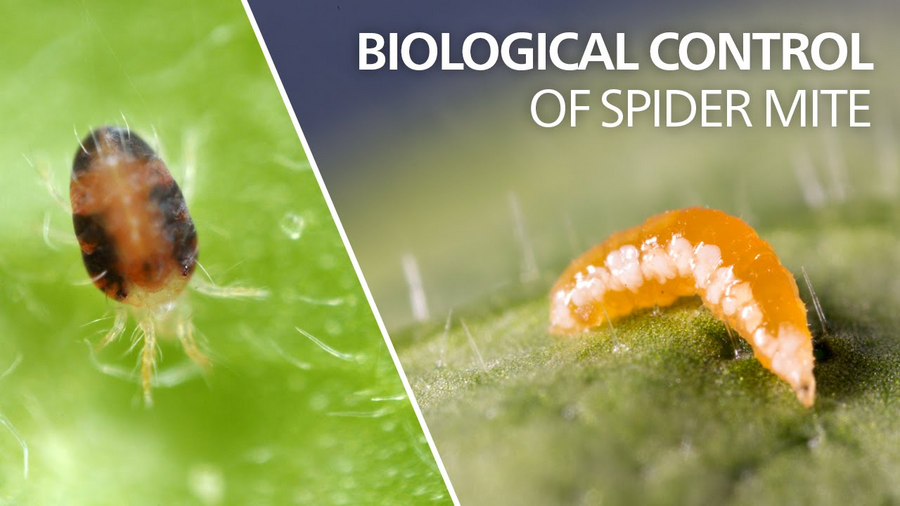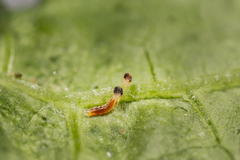Feltiella acarisuga is a predatory gall midge highly effective in the biological control of spider mites. This beneficial insect, native to Europe, preys on various spider mite species, in particular the two-spotted spider mite. Feltiella acarisuga is a key component in integrated pest management (IPM) strategies, offering growers a sustainable solution for spider mite infestations. By using Feltiella acarisuga in their pest management programs, agricultural and horticultural producers can protect their crops from spider mites while reducing reliance on chemical pesticides. This natural predator ensures healthier crops through effective biological control.
Spider mite control with Feltiella acarisuga
The predatory gall midge Feltiella acarisuga is used for the control of the following pests:
Some of the common spider mites targeted by Feltiella acarisuga includes two-spotted spider mite (Tetranychus urticae), strawberry spider mite (Tetranychus turkestani), Kanzawa spider mite (Tetranychus kanzawai) and many others. The natural enemy Feltiella acarisuga is available at Koppert as Spidend.
Koppert products
How to use Feltiella acarisuga
The predatory gall midge Feltiella acarisuga is available in plastic cups (Spidend).
-
Make a hole in the lid and place the cup on the rock wool slab or directly on the soil
-
Protect against direct sunlight and water
-
Leave the cup in place for at least two weeks
The dosage of Spidend depends on climate, crop and spider mite density and should always be adjusted to the situation. Start introduction as soon as the first spider mites are detected in the crop. Introduction rates typically range from 0.25-25 per m2/release. Releases should be repeated at least 3 times at weekly intervals, or until the pest is controlled. Consult a Koppert advisor or a recognized distributor of Koppert products for advice on the best strategy for your situation.
Best conditions for use of Feltiella acarisuga
Optimal results are achieved in a humid environment (>80% relative humidity) and at temperatures between 20 and 27°C (68 and 81°F).
Feeding behaviour of Feltiella acarisuga
Feltiella acarisuga works best when spider mites occur in colonies and can be used in combination with the predatory mites Phytoseiulus persimilis and Neoseiulus californicus. Immediately after emerging from the eggs, the midge larvae start to feed on spider mite eggs, nymphs and adults. They use their mouthparts to first immobilise their prey and then suck out the contents. The larvae also eat spider mites that are in diapause and can consume 15 adult spider mites or up to 50 mite eggs per day. They are aggressive and adapt the amount of food they consume to the density of the spider mite population. Where there are large, localised concentrations of spider mite, Feltiella acarisuga is a good control agent. The adults are not predatory and only need water and sugar.
Life cycle of Feltiella acarisuga
Growers can distinguish between the various life stages of the predatory gall midge, Feltiella acarisuga, when employing it as a biocontrol agent through careful observation of specific characteristics at each stage:
-
Egg Stage: Feltiella acarisuga females deposit their eggs on leaves and webs in and around spider mite colonies. The eggs are often laid near leaf veins. They are transparent to light yellow, slightly longer than the diameter of spider mite eggs and almost banana shaped.
-
Larval Stage: The colour of the larva is usually orange but can vary according to the colour of prey eaten and may sometimes be yellow or red. Immediately after emerging from the egg, the larva is yellowish white. The eggs and the first larval stages are very difficult to find in the crop due to their small size and colour.
-
Pupal Stage: After completing their larval development, Feltiella acarisuga larvae enter the pupal stage. Pupae are often found in sheltered locations, such as leaf crevices or within the soil. Initially, they appear pale green but gradually darken as they mature. Pupal cases are elongated and slightly curved, resembling tiny grains of rice.
-
Adult Stage: As development progresses, a red spot appears anterior to the midline, after which the entire larva becomes darker. Finally, white spots appear on the body. A fully grown larva is about 2 mm long. At the end of the last larval stage, the larva spins a white cocoon near a leaf vein and pupates within it.
By closely monitoring their crops and identifying the presence of eggs, larvae, pupae, and adults of Feltiella acarisuga, growers can gauge the effectiveness of this biocontrol agent in managing spider mite populations and promoting sustainable pest management practices.


